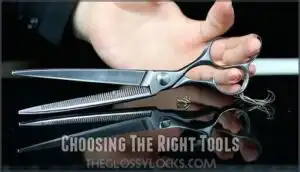This site is supported by our readers. We may earn a commission, at no cost to you, if you purchase through links.

For straight hair, use the sliding technique by running your fingers down each section and snipping visible splits. Curly hair responds best to the twisting method—twist small sections to reveal damaged ends, then cut above the splits. The dusting technique works for all hair types, removing just the tips of damaged strands.
Work in good lighting and take your time. Your hair will thank you, and there’s more to mastering this money-saving skill.
Table Of Contents
- Key Takeaways
- What Causes Split Ends?
- Which Tools Do You Need for Trimming?
- How to Prepare Hair for Trimming
- Step-by-Step Split End Trimming Methods
- Trimming Techniques for Different Hair Types
- How Often Should You Trim Split Ends?
- How to Prevent and Repair Split Ends
- Frequently Asked Questions (FAQs)
- Is it good to trim split ends at home?
- How to cut split ends by yourself?
- How can I remove split ends from my hair at home?
- How to clip split ends on natural hair?
- How to identify split ends in curly hair?
- Best tools for cutting split ends at home?
- Can split ends cause hair color to fade?
- Are there supplements to help prevent split ends?
- Does trimming split ends also remove frizz?
- Can you trim split ends without cutting length?
- Conclusion
Key Takeaways
- You’ll need professional hair shears and sectioning clips—kitchen scissors won’t work and will create more damage than they fix.
- Choose the right trimming technique for your hair type: use the sliding method for straight hair, the twisting method for curly hair, or the dusting technique for minimal length loss.
- Trim split ends every 6-8 weeks to prevent damage from spreading up the hair shaft and maintain healthy growth.
- You can prevent most split ends by using deep conditioning treatments weekly, limiting heat styling to under 300°F, and protecting your hair with thermal sprays.
What Causes Split Ends?
You’ll find split ends happen when your hair cuticle weakens from heat styling, chemical treatments, over-washing, or simply regular wear and tear.
Think of your hair like a rope that frays over time—the protective outer layer breaks down, causing the strand to literally split at the end.
Hair strands weaken and fray like rope over time, literally splitting apart when the protective outer layer breaks down
Hair Damage From Heat
Heat styling tools like flat irons and blow dryers reach temperatures that literally cook your hair. This thermal damage breaks down hair’s protein structure, leading to split ends and breakage. Without proper thermal protection, you’re setting yourself up for frequent hair trims.
Common heat damage sources include:
- Flat irons and curling tools exceeding 350°F
- Daily blow-drying without heat protectant sprays
- Hot rollers and styling wands used repeatedly
Always use thermal protection products and lower heat settings for effective split end prevention.
Damage From Chemicals
Chemical processing strips your hair’s protective cuticle, leaving strands vulnerable to chemical damage and hair breakage. Hair coloring, perms, and relaxers weaken protein bonds, creating split ends that require regular hair trim sessions.
Product buildup from harsh treatments blocks moisture, accelerating hair damage. Choose chemical-free alternatives and invest in color protection products for better hair care and hair repair.
Over-Washing and Dryness
Excessive washing strips away your hair’s natural oils, leaving strands vulnerable to hair damage and split ends. When you over-wash, you create a dry scalp that can’t maintain proper hair moisture levels.
This disrupts hair porosity, making strands brittle and prone to hair breakage. Daily shampooing becomes your hair’s worst enemy, causing frizz control issues and requiring frequent hair trim sessions for damage repair.
Normal Hair Weathering
Time works against your hair like weather against a mountain. Daily brushing, styling, and environmental exposure create weathered ends that eventually split. Your hair cuticles wear down from friction against pillowcases, clothing, and even your hands running through strands.
- UV rays break down hair proteins, weakening strand structure
- Wind tangles and roughens hair cuticles, promoting hair breakage
- Humidity changes cause swelling and shrinking cycles in hair shafts
- Age naturally reduces oil production, decreasing hair moisture levels
- Regular manipulation from brushing creates microscopic damage over time
Regular hair trim sessions combat this natural weathering process, maintaining split end prevention and frizz control.
Which Tools Do You Need for Trimming?
You’ll need professional hair shears and sectioning clips to trim split ends effectively at home. Kitchen scissors won’t cut it – they’ll create more damage and leave you with frayed ends that look worse than when you started.
Choosing The Right Tools
Now that you understand what damages your hair, let’s talk tool selection. Professional hair shears make all the difference – they’re sharper than household scissors and won’t crush your hair cuticles. Look for salon scissors with 4.5-6 inch blades made from Japanese or German steel.
Skip drugstore trimming kits that dull quickly and cause more split ends than they fix. When choosing the right tool, consider the benefits of high grade steel for a better cutting experience.
Sanitizing Shears
Before you begin trimming, proper shear sterilization protects against bacteria and infections. Clean your blade cleaning routine with 70% isopropyl alcohol or professional sanitizing solutions. Wipe down the blades thoroughly, then let them air dry.
This hygiene practice mirrors what any hair stylist does between clients. Tool maintenance isn’t just professional courtesy—it’s essential for healthy hair trimming tips and safe trims.
Sectioning Hair
Professional hair sectioning transforms chaotic trimming into precise cuts. You’ll need sectioning clips to divide your hair into manageable portions—think quadrants like a hair stylist uses.
This hair partitioning technique prevents missed spots during sectional trimming. Proper clip techniques guarantee each section stays secure while you work.
Master this trimming tool approach for consistent hair growth maintenance.
How to Prepare Hair for Trimming
Proper hair preparation sets the foundation for effective split end trimming and ensures clean, precise cuts. You’ll need to start with freshly washed hair that’s completely dry, properly detangled, and sectioned systematically to avoid missing damaged areas during your DIY trim session.
Washing and Drying Hair
Start with clean hair for accurate split end identification. Use sulfate-free shampoo and apply conditioner from mid-length down, focusing on moisture retention.
Gently towel-dry without rubbing, then air-dry or use low heat settings.
Proper hair care tips help your trimmed ends stay healthy longer, supporting natural hair growth while preventing future split ends.
Detangling and Sectioning
Once your hair’s clean and dry, you’ll need to tackle hair tangles before sectioning. Use detangling tools like a wide-tooth comb to work through knots gently. Proper hair combing prevents breakage during sectional trimming.
- Start detangling from ends, working upward
- Use sectioning clips to divide hair into manageable portions
- Apply leave-in conditioner to stubborn tangles
- Create 4-6 sections for thorough split ends removal
This preparation ensures you won’t miss damaged areas during your trim.
Setting Up Your Workspace
Creating the perfect trimming station transforms chaos into control. You’ll need good lighting, a comfortable chair, and a clean surface for workspace organization.
Place your sanitized shears, sectioning clips, and mirror within arm’s reach for an ergonomic setup. This trimly arranged environment ensures each trim feels professional and precise.
Step-by-Step Split End Trimming Methods
You’ll learn four effective trimming methods that target split ends while preserving your hair’s length and health.
Each technique works with different hair types and damage levels, so you can choose the approach that fits your specific needs.
Dusting for Minimal Hair Loss
When you’re feeling protective about your hair length, hair dusting becomes your secret weapon for split end removal. This minimal trimming technique preserves maximum hair while targeting damaged ends precisely.
- Work with completely dry hair for accurate assessment
- Take small sections and examine each strand closely
- Trim only the visible split portions using sharp shears
- Cut approximately 1/4 inch above each damaged area
- Move systematically through all sections for thorough coverage
This gentle cutting method maintains your hair’s overall length while eliminating troublesome split ends that could travel upward.
Twisting for Curly Hair
Curly hair benefits from twist techniques that reveal hidden split ends. Take one-inch sections and twist tightly until damaged ends stick out.
Use professional shears to snip protruding splits while maintaining curl definition. This method preserves your hair’s natural texture and length.
Focus on hair sectioning systematically to guarantee thorough trim maintenance without compromising your curls’ bounce.
Sliding for Straight Hair
The sliding technique works best for achieving straight trims on naturally straight hair. Start with clean, 100% dry hair and sharp shears. Slide your fingers down each section, stopping where you spot split ends.
This hair sliding method creates smooth, even cuts while preserving length. The straightening techniques help identify damaged areas that need trimming, making split end removal more precise and effective.
Trimming for General Use
For general trimming that works across all hair texture types, you’ll cut straight across wet hair sections. Hold your cutting tools perpendicular to the hair shaft and trim roughly half an inch above visible damage.
This method reduces split ends while maintaining styling options. Regular trims every six to eight weeks provide consistent trim benefits for healthier hair growth.
Trimming Techniques for Different Hair Types
Your hair type determines which trimming technique will work best for maintaining healthy ends and preventing further damage.
Each hair texture requires specific approaches, whether you’re working with straight strands that need clean horizontal cuts or curly hair that benefits from individual curl trimming.
Trimming Straight Hair
Straight hair trimming requires precise sectioning and clean cuts. Use professional hair shears to slice through each section horizontally, maintaining even tension. Work from back to front, cutting small amounts at a time.
Point-cutting techniques soften harsh lines while removing split ends effectively.
Regular trims every six weeks prevent damage from spreading up the hair shaft.
Trimming Curly Hair
Working with hair texture becomes more complex as curls demand individualized trim maintenance. Each curl pattern requires specialized Curly Hair Tips to prevent damage during Natural Hair Care routines. Curls tend to get dry and are even more susceptible to split ends.
Professional Curly Cut Styles benefit from:
- Cutting individual curls at their natural break points
- Using sharp shears to avoid fraying damaged ends
- Working with wet hair products for better visibility
- Trimming each section systematically from crown to nape
- Preserving curl pattern while removing split ends
Trimming Natural Hair
Natural hair requires gentle trimming techniques that respect your curl pattern. You’ll trim each curl individually when hair’s completely dry. This method preserves your natural texture while removing damaged ends effectively.
| Technique | Best For | Key Benefit |
|---|---|---|
| Curl-by-curl trim | Coily/kinky textures | Maintains natural shape |
| Search-and-destroy | Light damage | Targets specific splits |
| Dusting method | Regular maintenance | Minimal length loss |
Use sharp hair trim tools and natural hair care products for best Hair Growth Maintenance.
How Often Should You Trim Split Ends?
You’ll need to trim split ends every 6-8 weeks to prevent damage from spreading up the hair shaft. Your trimming schedule depends on your hair type, styling habits, and how quickly your hair grows—think of it like regular maintenance for your car’s engine.
Frequency for Short Hair
Short hair trims need attention every four to six weeks since shorter styles show growth faster. Your hair growth rates average half an inch monthly, making split end prevention essential for maintaining shape.
Trimming regularly keeps your cut looking fresh and prevents damage from traveling up the hair shaft, especially important for pixie cuts and bobs.
Frequency for Long Hair
Long hair requires trimming every 8-12 weeks to maintain healthy growth rates and prevent split end progression. Your hair’s condition determines the exact trimming schedule needed for ideal hair maintenance. Here are key Long Hair Trimming considerations: 1. Growth vs. Damage Balance – Trim every 10-12 weeks if you follow a consistent Hair Care Routine with minimal heat styling 2. Chemical Processing Impact – Reduce intervals to 6-8 weeks when using color treatments or relaxers for effective Split End Prevention 3. Length Goals Strategy – Schedule micro-trims every 8 weeks to preserve length while removing damaged ends through proper Hair Styling Advice
Scheduling Trims
Book trims every 6-8 weeks to stay ahead of damage and maintain your Hair Care Routine. Regular Maintenance works like insurance for Hair Growth—small investments prevent major losses. Use calendar reminders or salon apps for consistent Trim Scheduling.
Your hair’s unique Trim Frequency depends on styling habits and texture. This Split End Prevention strategy keeps your haircut looking fresh between visits. Understanding the importance of regular trims helps in creating an effective hair care plan.
How to Prevent and Repair Split Ends
You can prevent most split ends by using deep conditioning treatments weekly and limiting heat styling tools to temperatures below 300°F.
Regular protein masks and protective serums create a barrier against environmental damage while maintaining your hair’s natural moisture balance.
Using Conditioner and Hair Masks
Through regular deep conditioning treatments, you’ll lock in moisture and strengthen weakened hair strands. Apply protein repair masks weekly to rebuild damaged cuticles while nourishing treatments penetrate deeply into each strand.
These moisture locking formulas prevent future splits by keeping hair hydrated between trims. Remember, consistent conditioning makes your trimming efforts last longer and maintains overall trimness.
Limiting Heat and Chemical Damage
Since heat damage and chemical processing accelerate split end formation, you’ll need strategic damage control measures. Heat protection sprays create barriers before styling, while switching to chemical-free products prevents further weakening.
Consider these hair repair essentials:
- Use heat protectant before any styling tool
- Choose sulfate-free, gentle styling products
- Limit chemical treatments like coloring or perms
Regular trimming removes existing damage while these Hair Damage Prevention steps protect new growth.
Gentle Hair Care Practices
Three simple changes can transform your hair care routine. Use a wide-tooth comb for gentle combing to reduce breakage and preserve your freshly trimmed ends.
Apply hair oil benefits through regular scalp massage sessions, which boost circulation while protecting strands.
Natural styling methods paired with weekly hair masks create the perfect foundation for maintaining healthy hair between trims.
Frequently Asked Questions (FAQs)
Is it good to trim split ends at home?
Trimming split ends at home can work, but you’ll get better results with professional shears rather than household scissors.
Use proper techniques like sectioning your hair to avoid missing damaged areas.
How to cut split ends by yourself?
Why struggle with damaged ends when you hold the scissors? Use professional-grade shears on dry hair, twist small sections, and snip protruding splits with vertical cuts for clean results.
How can I remove split ends from my hair at home?
You’ll want professional shears and good lighting to spot damaged ends effectively. Twist small hair sections, then snip protruding splits carefully. Work methodically through each section for thorough removal.
How to clip split ends on natural hair?
Section your dry natural hair into small 1-inch pieces using clips. Twist each section tightly and snip the split ends that stick out with sharp hairdressing scissors held vertically for precision.
How to identify split ends in curly hair?
Look for single strands that appear frayed, forked, or have white dots along the shaft.
Gently stretch individual curls to examine ends closely – damaged hair will show clear splits or multiple branches extending from one strand.
Best tools for cutting split ends at home?
Sharp scissors become your hair’s best friend when tackling split ends at home. You’ll need professional-grade hair shears, sectioning clips, and a wide-tooth comb for clean, precise cuts that prevent further damage.
Can split ends cause hair color to fade?
Split ends damage hair cuticles, causing them to open and lose color molecules more quickly. You’ll notice faster color fading because damaged hair can’t hold pigment effectively.
Are there supplements to help prevent split ends?
Biotin, collagen, and omega-3 supplements can strengthen your hair and reduce breakage that leads to split ends. You’ll also benefit from vitamin E and silica for healthier hair structure overall.
Does trimming split ends also remove frizz?
Don’t beat around the bush – trimming split ends does help reduce frizz. Split ends create rougher hair surfaces that catch light differently and feel coarser to touch.
Regular trimming can reduce frizz, improve hair texture, and promote healthier growth.
Can you trim split ends without cutting length?
Yes, you can trim split ends without losing significant length using targeted techniques. Try the twist-and-trim method: twist small hair sections and snip only protruding damaged ends with sharp shears.
Conclusion
Mastering how to trim split ends at home is like having a secret weapon in your hair care arsenal. You’ve learned the essential techniques—dusting, twisting, and sliding—that keep your strands healthy between salon visits.
Remember to use sharp shears, work in good lighting, and trim regularly based on your hair type. With consistent practice and proper tools, you’ll maintain stronger, healthier hair while saving money and time.
- https://www.mindbodygreen.com/articles/how-to-trim-split-ends
- https://winstonindia.com/blogs/winston-blogs/how-to-trim-your-own-split-ends
- https://www.splitenderpro.net/products/split-ender-mini-silver-split-end-hair-trimmer-by-talavera
- https://www.youtube.com/watch?v=tkZ6HOFijuM
- https://www.rehairducation.com/taking-a-closer-look-at-split-ends/














